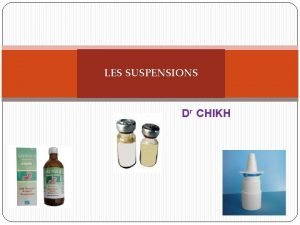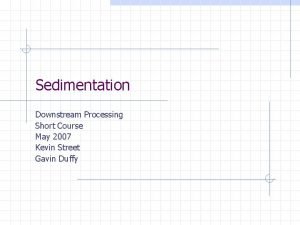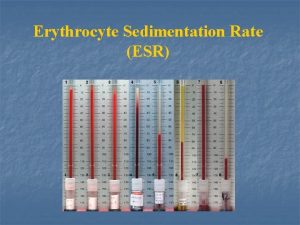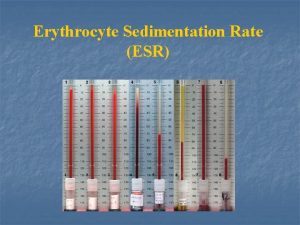Erythrocyte Sedimentation Rate ESR Erythrocyte Sedimentation Rate It













- Slides: 13

Erythrocyte Sedimentation Rate (ESR)

Erythrocyte Sedimentation Rate It is the rate of downward descent of RBCs in a vertical column of blood. Principle: If anti-coagulated blood is allowed to stand vertically in a narrow tube , the red cells will settle progressively to the bottom leaving clear plasma above.

1 -Density of RBCs is greater than that of to form Rouleaux. (Rouleaux differs from agglutinatin that agglutinated cells are irreversibly bound together and can not be separated )

Rouleaux formation.

Westergren method for estimation of ESR : Equipments: -Westergren tube ( straight glass tube 30 cm in length , 2. 5 mm in dimeter and graduated from 0 – 200 mm ) -Special stand. -3. 8% Sodium Citrate. -5 ml disposable syringe.

Procedure : 1 -Withdraw blood sample in a syringe and mix it with 3. 8% Na Citrate at a ratio 4 : 1 (e. g. 2 ml blood + 0. 5 ml Na Citrate) 2 -suck the citrated blood to Westergren tube up to zero mark exactly and place your finger over its openning. 3 -Place the tube in a special stand that fix the upper lip with a clip. 4 -The height of clear plasma on the top of the tube is measured after one and two hours.

Westergren tube for ESR.

Normal values : -In males : 1 st hr : 3 -5 2 nd hr : 6 -10 -In females : 1 st hr : 8 -10 2 nd hr : 16 -20 mm mm

Clinical significance of ESR : -Because the ESR is changed in a great variety of conditions , Its alteration is not specific and not diagnostic. -It is a prognostic test : 1 -It detects the presence and severity of disease. 2 -It gives an idea about the activity of disease 3 -Repeated ESR estimation helps in prognosis and follow up of disease

Factors determining the rate of sedimentation of RBCs : 1 - plasma proteins : a- Albumin : If plasma albumin level is increased the ESR decreases. b- Fibrinogen and globulins : If plasma fibrinogen or globulins level is increased the ESR increases. 2 - Red cell count : - If RBCs count is increased the ESR decreases.

Factors affecting ESR : A- Physiological factors : a- ESR is increased in : 1 -Old age. 3 - Prgnancy. b- ESR is decreased in : 1 - Newborn. 3 - High altitude. 2 -Females. 4 -Menestruation. 2 - Males.

B- Pathological factors : a- ESR is increased in : 1 -Acute inflammation as tonsillitis. 2 - Malignancy. -Chronic inflammation as T. B. 4 - Fevers. fever. 6 -Tissue trauma. b- ESR is decreased in : 1 -polycythemia. 2 -Hyperviscosity of plasma.

Thank YOU With my best wishes Prepared by : Dr. Khaled Saleh.
 Corrected esr chart
Corrected esr chart Pronormoblast
Pronormoblast Erythocyte sedimentation rate
Erythocyte sedimentation rate Normal esr rate
Normal esr rate Esr normal range
Esr normal range Esr normal range in male
Esr normal range in male Loi de stokes vitesse de sédimentation
Loi de stokes vitesse de sédimentation Definition sedimentation
Definition sedimentation Lovo sedimentation tank
Lovo sedimentation tank Application of sedimentation in industries
Application of sedimentation in industries Sedimentation technique for stool concentration
Sedimentation technique for stool concentration Rectangular primary clarifier
Rectangular primary clarifier Sedimentation in downstream processing
Sedimentation in downstream processing Sedimentation velocity
Sedimentation velocity























